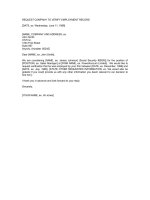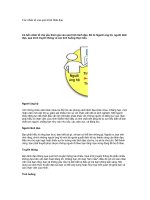Tài liệu Three Keys to Encourage Positive Behavior in Your Child docx
Bạn đang xem bản rút gọn của tài liệu. Xem và tải ngay bản đầy đủ của tài liệu tại đây (53.03 KB, 13 trang )
Three Keys to
Encourage Positive
Behavior in Your
Child
by Robyn Ladinsky, MSW
Life and Parenting Coach
www.robynladinsky.com
I. Introduction
II. Feelings
III. Discipline
A. Rewards
B. Punishment
C. Natural Consequences
D. Logical Consequences
IV. Consistency
V. Where to Start
INTRODUCTION
Being a parent is one of the most difficult jobs a person will ever have. We all
want the best for our children and for them to live a life full of love, happiness and
abundance.
There’s so much excitement when a child is born; all the hopes and dreams. As the
baby grows and begins to explore their world, parents often begin to feel frustrated
and overwhelmed at how to best manage the new behaviors exhibited by their
child.
Below, you will find three keys in helping you manage your child’s behavior. You
will learn:
• Why acknowledging and accepting your child’s feelings and perceptions are
vital.
• Why rewards and punishments don’t work.
• What types of discipline does work and why.
• The importance of consistency.
• Where to get started.
FEELINGS
There is a direct correlation between how a child feels and how he behaves. When
a child feels good, he will not only exhibit good behavior, he will also exhibit good
physical health. In addition to implementing appropriate consequences (which will
be explained below), it is also important to acknowledge and accept your child’s
feelings and perceptions.
Some examples of common phrases parent’s say to their children are “You don’t
really feel that way,” “You’re just saying that because you’re tired, you don’t
really mean it,” or “There’s no reason to be upset.”
Saying these types of things to your children teaches them to not trust their own
feelings. If you aren’t sure, just try putting yourself in your child’s shoe and look
at the situation from their point of view. Adults often don’t question each other
when someone has a different feeling or perception from theirs, so why should
parents question those of their children?
When someone is feeling upset, the one thing most people want is to be heard and
to have their feelings acknowledged. This allows the pain to be acknowledged
which then leads to one feeling less upset and confused and thus, more able to cope
with one’s feelings and problems. This is true for both children and adults.
DISCIPLINE
Discipline helps parents to communicate respect to their children. It teaches
accountability and helps them to develop a conscience. To do this, a parent will
first need to set appropriate guidelines and limits.
When children do not follow these rules, it is the parent’s responsibility to
encourage and inspire their children to improve their behavior. One way to do this
is by implementing appropriate consequences.
There are four basic types of consequences: rewards, punishment, natural and
logical.
REWARDS
A reward is something given to the child when she behaves appropriately in hopes
that she will continue to behave in this manner. Many parents believe this to be a
positive approach to discipline.
Instead, what happens is the child begins to expect a reward every time she does
what she is supposed to do. The reward, in a child’s eye, becomes her right. As a
result, the child can develop an attitude of “What’s in it for me?” which, in regards
to discipline, teaches the child to expect rewards for positive behavior.
Parents will often have to raise the value of the reward to keep the positive
behaviors which can often lead to parental frustration. This also leads the child to
only behave appropriately in order to get more things instead of for the reason
parents ultimately want which is because “it’s the right thing to do.”
PUNISHMENT
Punishment is the deliberate removal of something a child enjoys for a period of
time or to inflict pain in order to teach a lesson regarding his misbehavior. Many
parents often believe that to make their children behave, they must first make them
feel worse. It often seems to work for the moment, but it often backfires as
evidenced by the child’s reactions.
Since punishments rarely work, parents often believe that it wasn’t severe enough
and will thus increase the severity. Sometimes, the punishment is also combined
with harsh words such as “I can’t believe you’re doing this again” or “You’re so
stupid.”
If the behavior does stop, then the child is doing so out of fear of further
punishment instead of feeling sorry for what he’s done and taking responsibility
for his own actions.
After being punished, children are often left with a feeling of unfairness. Their
anger is focused on the person implementing the punishment instead of their
misbehavior.
They are often full of thoughts of resentment such as “This is unfair” or “I can’t
trust adults.” Reactions show up in the form of seeking revenge, becoming
rebellious or decreasing their self-esteem.
Seeking revenge is when the child wants to “get back” at the person who inflicted
the punishment. One such way is to continue the misbehavior, but with more
intensity or to change misbehaviors to a different kind.
Becoming rebellious gives into the thought of “I won’t get caught next time.” This
leads to sneakiness, deceit and power struggles.
Decreasing their self-esteem comes as a result of self-defeating thoughts such as
“I’m a bad person,” “I can’t do anything right,” or “I’m not good enough.”
All of these reactions begin a revenge cycle that sometimes may not be noticed
until the teenage years when behaviors such as running away, alcohol and drug
abuse, etc. show up. The child ends up hurting himself more than the parents.
NATURAL CONSEQUENCES
A natural consequence is one that comes as a natural result (without adult
interference) as a result of the child’s behavior. For example, a natural
consequence of a child going outside in cold, rainy weather will result in his
becoming wet and cold. Another example is if the child doesn’t put his dirty
clothes in the hamper to be washed, he may not have clean clothes to wear or at
least the outfit he wants to wear.
There are a couple of exceptions where allowing natural consequences to take
place is not okay. These are if the consequence would put the child in danger or if
the behavior would result in interfering with the rights of others.
LOGICAL CONSEQUENCES
Logical consequences are ones that are logically connected to the misbehavior,
administered in a calm and firm manner, intended to teach responsible behavior
and which are respectful. Even if the child doesn’t like the consequence, he does
experience it as being fair. Logical consequences help children learn to be
contributing members of society which generally enhances their self-esteem, their
sense of belonging and feelings of significance. It’s important that they be related
to the behavior, respectful of the child and reasonable.
For example, if a child spills milk on the table, a logical consequence is for him to
clean it up. This is one that is related to the behavior. If the statement “How could
you be so clumsy?” were added, then it would not be respectful; instead, say
something like “Oops, what do you need to do?” Having the child only clean up
the spilled mess would be reasonable whereas having him clean up the whole
kitchen would not be.
CONSISTENCY
When first starting to implement logical consequences instead of rewards and
punishments, your children will test you. It can be difficult, but it is important to
remain calm and firm during this transitional period. You can implement logical
consequences nine times in a row and then not do so the tenth time and you’ll be
back to square one. It’s important to remember that not only are you retraining
your child to behave differently, you are also retraining yourself. Your child needs
to know you mean business.
WHERE TO START
Now that you know the basics of managing your child’s behavior, you may be
asking yourself, “Now what?” Below are a few steps, which can also be applied in
other areas of your life, to get you started.
CREATE A VISION
When things aren’t going the way we’d like, it’s not uncommon to focus on the
things that aren’t working. This can also make the future look pretty bleak.
One of the first things to do is to decide how you want things to be. If a lot of time
and energy is spent addressing your child’s misbehavior, then you’re probably not
enjoying each other and having fun. Take a few minutes and fantasize what you
would like things to look like. Be sure to keep it positive and to write it down so
you can look at it often.
SETTING GOALS
Once you have a vision of how you want things to be, it’s time to get specific. One
of the easiest ways to do this is to first make a list of the behaviors you don’t like.
Then, next to each one, rewrite the behavior as if it were what you did want. For
example, the behavior you don’t like is to “stop leaving toys out all over the
house.” The opposite would be “toys to be picked up when they are finished being
played with.”
TRY SOMETHING NEW
If what you’ve been doing was working, you probably would not be reading this
report, so it’s time to try something new. If you have not been acknowledging and
accepting your child’s feelings, then try doing that. If your discipline methods
have been full of rewards and punishment, try implementing logical consequences
as well as allowing natural ones to occur.
For further information on how to work with specific misbehaviors that are
showing up in your family, send an email to
and I will
be happy to do what I can to help you.
Stay tuned for future reports, e-books, programs, etc. on managing your child’s
behavior and other issues related to parenting.









